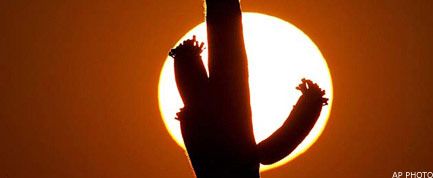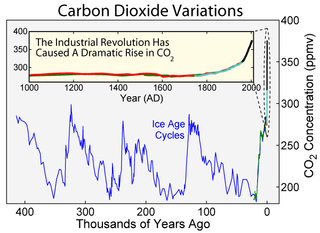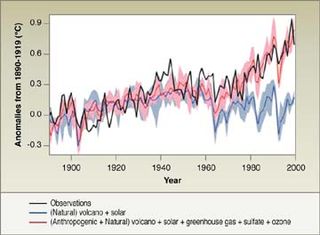What Are Climate Change Skeptics Still Skeptical About?

Richard Muller used to be a global warming skeptic. A prominent physicist at the University of California, Berkeley, Muller didn't trust the level of rigor — or the results — of past climate studies. As he explained in editorials that were often cited by other skeptics, he thought the dramatic global temperature rise reported by NASA and many other groups may have stemmed from systematic measurement errors rather than an environmental catastrophe.
Instead of leaving it at that, Muller founded the Berkeley Earth Surface Temperature (BEST) study in 2010 to do the job right. His team of statisticians, physicists and climate experts conducted an exhaustive analysis of 200 years of global temperature data, running 1.6 billion temperature reports from 39,000 recording stations through a complex process that filtered out questionable data and averaged the rest.
Today, Muller no longer doubts the reality of global warming.
The BEST team's rigorous analysis showed that the average global land temperature has risen by 1 degree Celsius since the 1950s. The finding exactly matches those of past studies by the National Oceanic and Atmospheric Administration (NOAA), NASA and others. But this time, Muller says that because his team cleaned up the data in ways no other study has, their result is rock-solid.
Earth's climate is extremely sensitive to temperature fluctuations: That one degree of rapid warming is believed to be driving major changes to weather patterns — causing, for example, drought and rapid desertification in arid regions of the globe. The effects have been felt in the United States, with the Southwestern part of the country experiencing its worst drought in centuries. Global warming is also melting the polar ice caps, which, consequently, is raising sea levels worldwide and threatening to drown hundreds of coastal cities.

Furthermore, the vast majority of climate scientists attribute global warming to deforestation and the burning of fossil fuels — coal, oil and natural gas. These activities have poured millions of tons of greenhouse gases, particularly carbon dioxide (CO2), into Earth's atmosphere over the past few decades. The concentration of CO2 in the atmosphere has risen from about 280 parts per million (ppm) in preindustrial times to 392 ppm today, its highest level in at least 800,000 years (as far back as the ice core record goes), and probably higher than in the past 20 million years. Like the roof of a greenhouse, the thickening layer of CO2 traps heat at the Earth's surface, and if the rate of human carbon emissions continues to increase, global warming is expected to accelerate in the near future, so that by 2100, Earth will be at its warmest in millions of years. [5 Ways the World Will Change Radically This Century]
This is the consensus view among scientists. However, a small but vocal handful of academics — some of them climatologists, others in outside fields — believe the whole thing is a case of alarmism. Some argue that global warming isn't actually happening. Others concede that Earth is warming, but believe the process is natural (and has nothing to do with us humans). If they're right, then there's no need for the fossil fuel industry to cap carbon emissions, lesser developed countries should feel free to industrialize in the cheapest way possible (i.e. with carbon-spewing coal), and the rest of us can stop worrying about the fate of future generations.
Sign up for the Live Science daily newsletter now
Get the world’s most fascinating discoveries delivered straight to your inbox.
But the Berkeley study shows with a high level of confidence that global warming is real, and the overwhelming scientific consensus is that we're causing it. So what, exactly, are the skeptics' remaining arguments?
It's urban warming
Pat Michaels, a climatologist and senior research fellow for policy and economic development at the Cato Institute, has written several books arguing that the danger of global warming is overblown. Michaels believes CO2 emissions are having a warming effect on the Earth, but it's so small as to be negligible. Based on his calculations, "it amounts to about four-hundredths of a degree [Celsius] of spurious warming in a global temperature record since 1979," Michaels told Life's Little Mysteries, a sister site to LiveScience. That's orders of magnitude less than the total warming observed by BEST, NASA and NOAA and others.
He attributes the rest of the warming detected by those groups to inaccurate temperature measurements made in "urban heat islands": cities where the temperature reads higher than in surrounding areas because of the way concrete, stone and brick building materials retain heat.
However, several past climate studies have debunked the claim that urban heat islands are so hot that they're being mistaken for global warming; the BEST study thoroughly debunked that notion again. Muller and his colleagues compared temperature data recorded at thousands of rural and urban stations around the world and found a negligible difference in the upward temperature trend exhibited by both. If anything, cities have recently heated up at an ever-so-slightly slower rate than rural areas (though the difference is not statistically significant). "The key conclusion," the researchers wrote, is that "urban warming does not unduly bias estimates of recent global temperature change."
Michaels, who has been criticized for accepting research funding from the fossil fuel industry, rebuts this by arguing that BEST's negative urban effect couldn't possibly be correct, and so the whole study should be disregarded. "Muller's study says that the effect of cities on temperatures is to cool the temperature. Well, I don't think there's a climate scientist around who believes that that could happen — unless the cities are so polluted that the haze around them keeps the sunlight from hitting the ground," he said. "In China, there is some evidence that cities are cooler because of pollution." (In short, Michaels agrees that urban cooling can and does happen, but disagrees about the degree to which it does.)
It's actually getting cooler
Still, Michaels attributes almost all of the apparent 0.16 degrees Celsius warming per decade observed by climatologists to the bias of urban heating, rather than carbon emissions from fossil fuel use. However, he also says that even that warming seems to have stopped in the past decade. Similarly, Dennis Avery, a food policy analyst at the conservative think tank the Hudson Institute, and an outspoken advocate of pesticides and industrial-scale agriculture, argues that there is scientific evidence that the Earth has now entered a period of cooling, rather than warming.
"The U.S. Solar Observatory is now projecting decades of cooling as the current sunspot minimum continues — and the Pacific Decadal Oscillation has shifted into its 30-year cool phase," Avery wrote in an email. "The outlook for Dr. Muller’s position is shaky indeed, following the cool winters since 2007." [If Global Warming Is Real, Why Is It Still Snowing?]
It is true that the U.S. Solar Observatory recently detected a decrease in sunspots, pointing to a decline in magnetic activity on the sun's surface. A drop in solar activity also occurred in the 17th century, and it partly overlapped with a period of unusually cold weather now known as the "little ice age."
However, mainstream climatologists do not believe that variations in sunspot activity actually cause ice ages, little or otherwise. The 17th century cold spell is thought to have resulted from an upsurge in volcanic activity at that time that cloaked Earth in sunlight-blocking soot. Climate models show that reduced solar activity can produce no more than 0.3 degrees Celsius of cooling, and a 2010 study in Geophysical Research Letters showed that, even if we are entering another solar minimum period like the one that occurred in the 17th century, its cooling effect will be (and is being) completely dwarfed by the warming effect of greenhouse gas emissions.
In short, Avery's global cooling hypothesis is not supported by scientific research. But he makes another, more compelling argument — typically viewed as the most viable alternative to the mainstream view on climate change.
It's natural
Before he'll be convinced that humans are impacting the climate, "I would like some evidence that this modern warming is not part of the 1,500-year Dansgaard-Oeschger cycle, coming as it does at the appropriate time," Avery wrote in an email.
Dansgaard-Oeschger (D-O) events are natural climate fluctuations that occurred 25 times during the last ice age, approximately every 1,500 years. The events are relatively brief, but can have dramatic, lasting effects on Earth's temperature. Ice core samples taken in Greenland reveal that, when these events happened, they were marked by rapid warming of up to 8 degrees Celsius in the Northern Hemisphere in just 40 years, followed by gradual cooling.
Avery says such an event is happening now. His argument that global warming is part of this natural climate cycle was the subject of his book, "Unstoppable Global Warming: Every 1,500 Years" (Rowman & Littlefield, 2007), co-authored with atmospheric physicist Fred Singer (who has also been criticized for receiving funding from the fossil fuel industry). Theirs may be the most common argument espoused by climate change skeptics.
However, most climatologists say this scientific-sounding argument is greatly flawed. First, D-O events did not cause the same global warming patterns observed today, but rather acted to redistribute Earth's warmth. Ice cores drilled in Antarctica show that equal-and-opposite cooling in the Southern Hemisphere balanced out the warming that occurred to the Northern Hemisphere during D-O events.
Secondly, D-O events happened during the last ice age, not afterward. There is some evidence that the current interglacial period may also be experiencing 1,500-year climate cycles, called "Bond events," and that these may be related to D-O events. But Bond events have a much smaller impact on temperature than did D-O events — so small that not all scientists believe Bond events actually exist. If they do, then rather than being marked by dramatic rises in global temperature, they too cause a weak redistribution of heat around the globe.

Today, by contrast, all indicators point in only one direction: warming of the entire planet, and at a rate not seen during any past Bond event. The climatologist Gerard Bond, for whom Bond events are named, strongly disagrees with efforts by climate skeptics to use his research as proof that global warming is a natural phenomenon. As the Intergovernmental Panel on Climate Change stated in a recent report, "The rapid warming is consistent with the scientific understanding of how the climate should respond to a rapid increase in greenhouse gases like that which has occurred over the past century, and the warming is inconsistent with the scientific understanding of how the climate should respond to natural external factors." [See graph]
It's an error
Some skeptics just don't trust the quality of global temperature data enough to believe that it can reliably show a warming trend.
All climate models rely heavily on temperature records from thousands of recording stations around the world; if the stations are inaccurate, they can skew the results. In fact, it was Muller's concern that past climate studies might rely on too much erroneous temperature data that led him to found BEST. Statisticians on his team employed complex error analysis, averaging methods, and clever data filtering to minimize uncertainty in their set of 1.6 billion temperature reports; the team also separately analyzed a subset of the data coming from only the highest quality stations.
Though they ended up finding the same 1 degree C of warming since the 1950s that past climate studies found, they reduced the statistical uncertainty in that result nearly to zero.
But Michaels has written several editorials since late October arguing that it isn't surprising that the BEST team detected the same degree of warming as other studies, because they used the same set of temperature data.
This is not the case. In their analysis, the BEST researchers used more than five times more data than prior studies; they also looked at subsets of data that excluded all data analyzed previously. "Using only these previously unused data, we find no statistically significant difference [in warming trends]," Muller wrote in an email. When Michaels' error was pointed out to him, he responded that he meant a different part of the study corresponding to temperature reports from 1800 to 1850.
Muller said that data was also new. "Our analysis from 1800 to 1855 obviously uses new data sets, since no other group has ever published results prior to 1855. From 1855 onwards, we have now done the work that I described above using the 77 percent of the stations unused by the other groups."
Muller added that the BEST study has been met with a flurry of similar false criticisms in the past several weeks. "Be aware that many people are giving their knee-jerk reactions … without careful reading of our papers. That is unfortunate, but an inevitable consequence of the great interest our work has engendered. Our goal is not to convince people in the week or two following our release, but to convince them in the months that follow as they begin to appreciate the care that we took, and the validity of our analysis methods," Muller said.
It's unknowable
Some scientists believe that climate change and global warming are real, but think that their causes are unknown. In this small camp is Freeman Dyson, a prominent physicist at Princeton University.
"Of course climate change and global warming are real," Dyson wrote in an email to Life's Little Mysteries. "I am skeptical not about the facts, but about the claims of climate experts to understand the facts. To the question whether either the causes or the consequences of climate change are understood, I answer no."
Dyson believes carbon dioxide does have a warming effect on the Earth, but questions the extent of its influence. He believes climate models that strongly link global warming to the rapid rise in atmospheric CO2 are based on false assumptions about the effects of atmospheric carbon. However, in the past, Dyson has admitted that he does not know much about the technical facts involved in climate modeling.
These are the primary arguments made against global warming. The large platform given to those who voice them — prominently by some media outlets — has had an astounding impact on public opinion in the United States. A May 2011 survey found that only 47 percent of Americans attribute global warming to human activities, while 36 percent blame it on natural causes. A staggering 95 percent of people who reported being "disengaged," "doubtful" or "dismissive" of global warming had no idea that 97 percent of publishing climate scientists believe global warming is happening and that it is caused by humans.
It seems the media has inaccurately portrayed the climate debate by paying disproportionate attention to many of the unscientific claims laid out here. Is the damage irreparable?
This story was provided by Life's Little Mysteries, a sister site to LiveScience. Follow Natalie Wolchover on Twitter @nattyover. Follow Life's Little Mysteries on Twitter @llmysteries, then join us on Facebook.
Natalie Wolchover was a staff writer for Live Science from 2010 to 2012 and is currently a senior physics writer and editor for Quanta Magazine. She holds a bachelor's degree in physics from Tufts University and has studied physics at the University of California, Berkeley. Along with the staff of Quanta, Wolchover won the 2022 Pulitzer Prize for explanatory writing for her work on the building of the James Webb Space Telescope. Her work has also appeared in the The Best American Science and Nature Writing and The Best Writing on Mathematics, Nature, The New Yorker and Popular Science. She was the 2016 winner of the Evert Clark/Seth Payne Award, an annual prize for young science journalists, as well as the winner of the 2017 Science Communication Award for the American Institute of Physics.
